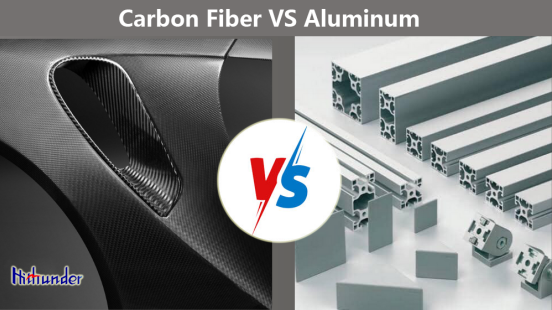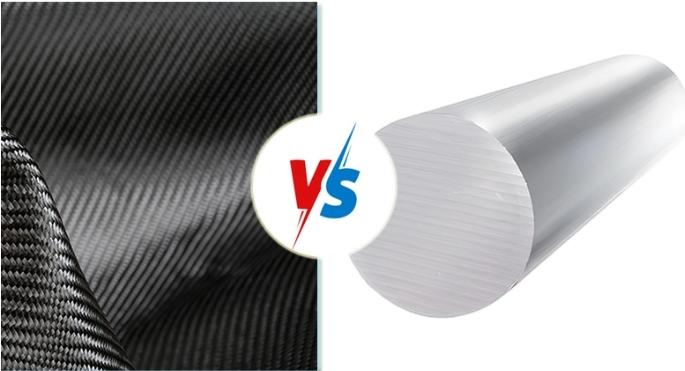In the world of high-performance materials, carbon fiber and aluminum are two heavyweight players. As the source manufacturer of carbon fiber and its products, Hithunder takes you to an in-depth understanding of the characteristics and costs of these two materials.
Comparison of the characteristics of carbon fiber and aluminum
● Weight: The density of carbon fiber composites produced by Hithunder is about 1.6 g/cm³, which is about 40-50% lighter than aluminum (density is about 2.7 g/cm³), which is particularly important in applications that need to reduce weight.
● Strength: The tensile strength of carbon fiber is as high as 3400-7000 MPa, far exceeding the 90 to 310 MPa of aluminum alloy. For example, the tensile strength of 7075 aluminum alloy is about 572 MPa, while Hithunder's carbon fiber products provide higher strength.
● Stiffness: The elastic modulus of carbon fiber is between 230 and 700 GPa, which is much higher than the 69 to 80 GPa of aluminum alloy, which makes carbon fiber show superior stiffness and bending resistance in high-performance applications.
● Heat resistance: Although aluminum has a thermal conductivity of 205 W/m·K, which is better than carbon fiber's 5-10 W/m·K, Hithunder's carbon fiber can remain stable at higher temperatures, while aluminum melts at about 660°C.
● Corrosion resistance: Carbon fiber itself is highly resistant to corrosion, and aluminum also exhibits good corrosion resistance after forming a protective oxide layer.

Cost comparison of carbon fiber and metal aluminum
● Cost: Carbon fiber is expensive due to its excellent performance. The price range of commercial-grade carbon fiber is $30 to $90 per kilogram, while aluminum costs less than $3 per kilogram.
● Manufacturing simplicity: The production process of carbon fiber is complex and time-consuming, while aluminum is easier to manufacture, through processes such as casting, extrusion and rolling, which are highly automated and efficient.
Application fields of carbon fiber and metal aluminum
● Aerospace: Carbon fiber is indispensable in aircraft components due to its lightweight and high-temperature resistance, while aluminum is also widely used in the aerospace industry.
● Automotive industry: High-performance vehicles use carbon fiber to reduce weight and improve performance, while aluminum is also widely used in various parts in the automotive field.
● Bicycles and sports equipment: Carbon fiber is a popular choice for high-end bicycles, golf clubs, tennis rackets, etc., while aluminum is also used in the manufacture of bicycles and various sports equipment.
● Medical and manufacturing: Carbon fiber is used for lightweight, high-strength equipment in the medical field, while aluminum is also prevalent in medical and manufacturing applications.
● Consumer electronics: Aluminum is preferred for housings and heat sinks in consumer electronics, and the light weight and high strength of carbon fiber also provide new design possibilities for consumer electronics products.

After an in-depth comparison of the performance and cost of carbon fiber and aluminum alloys, it is obvious that although aluminum alloys have a place in some applications due to their economical nature, their limitations cannot be ignored. The performance of aluminum alloys in terms of strength, stiffness and heat resistance is often not comparable to the excellent performance of carbon fiber composites. In particular, the limitations of aluminum alloy materials are more obvious in fields such as aerospace, high-end automotive manufacturing and precision medical devices that require extremely high performance.
The flexibility of carbon fiber composites is another major advantage. As the source manufacturer of carbon fiber and its products, Hithunder can adjust the weaving method and resin matrix of carbon fiber according to the needs of different applications, so as to achieve precise control of material properties. This customization capability enables carbon fiber composites to better adapt to changing industrial environments and complex engineering challenges.
In addition, the high added value brought by carbon fiber composites is also difficult to match by aluminum alloys. In today's pursuit of lightweight, high performance and environmental protection, the lightweight, high strength and corrosion resistance of carbon fiber not only improve the performance of products, but also extend the service life of products and reduce maintenance costs. These advantages make carbon fiber composites the preferred material for many high-end products and innovative technologies, bringing users higher economic benefits and market competitiveness.
In summary, although aluminum alloy has certain advantages in cost, its limitations in performance and lack of flexibility make it impossible to completely replace carbon fiber composites. Hithunder will continue to be committed to the research and development and application of carbon fiber technology, promote the widespread application of this high-performance material in more fields, and create greater value for customers.
